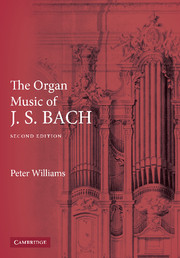Book contents
- Frontmatter
- Contents
- Preface
- List of abbreviations
- BWV 131a Fugue in G minor
- BWV 525–530 Six Sonatas
- Preludes and Fugues (Praeludia) BWV 531–552
- Eight Short Preludes and Fugues BWV 553–560
- Miscellaneous pieces BWV 561–591
- Concertos BWV 592–596
- BWV 597 and 598
- Orgelbüchlein BWV 599–644
- Schübler Chorales BWV 645–650
- Chorales formerly called ‘The Eighteen’ BWV 651–668
- Chorales from Clavierübung III BWV 669–689
- Chorales formerly called ‘The Kirnberger Collection’ BWV 690–713
- Miscellaneous chorales BWV 714–765
- Chorale variations (partitas) BWV 766–771
- BWV 790
- Four Duets from Clavierübung III BWV 802–805
- BWV 943, BWV 957, BWV 1027a and 1039a, BWV 1029.iii, BWV 1079.ii, BWV 1085
- Chorales now called The Neumeister Collection BWV 1090–1120
- Further works, in part of uncertain origin
- Calendar
- Glossary
- Bibliography
- Index of names
- Index of BWV works cited
Four Duets from Clavierübung III BWV 802–805
Published online by Cambridge University Press: 22 September 2009
- Frontmatter
- Contents
- Preface
- List of abbreviations
- BWV 131a Fugue in G minor
- BWV 525–530 Six Sonatas
- Preludes and Fugues (Praeludia) BWV 531–552
- Eight Short Preludes and Fugues BWV 553–560
- Miscellaneous pieces BWV 561–591
- Concertos BWV 592–596
- BWV 597 and 598
- Orgelbüchlein BWV 599–644
- Schübler Chorales BWV 645–650
- Chorales formerly called ‘The Eighteen’ BWV 651–668
- Chorales from Clavierübung III BWV 669–689
- Chorales formerly called ‘The Kirnberger Collection’ BWV 690–713
- Miscellaneous chorales BWV 714–765
- Chorale variations (partitas) BWV 766–771
- BWV 790
- Four Duets from Clavierübung III BWV 802–805
- BWV 943, BWV 957, BWV 1027a and 1039a, BWV 1029.iii, BWV 1079.ii, BWV 1085
- Chorales now called The Neumeister Collection BWV 1090–1120
- Further works, in part of uncertain origin
- Calendar
- Glossary
- Bibliography
- Index of names
- Index of BWV works cited
Summary
Published 1739, no Autograph MS. Later copies only.
‘Duetto’
Some uncertainty as to a suitable name for imitative two-part pieces is suggested by the term ‘Praeambulum’ for works in the CbWFB later called ‘Invention’ in the fair copy of 1723. Theorists understood ‘duetto’ as (i) a ‘petit duo’ above a bass (Walther's Lexicon 1732, after Brossard's Dictionaire 1703), (ii) a dialogue aria with an ‘opportunity to introduce and develop two subjecta opposita’ (Mattheson, Critica musica II, 1725, p. 28), (iii) an instrumental or vocal piece above a bass, ‘skilfully fugued’ (ibid. I, 1722, p. 131), and (iv) a two-part piece incorporating more than mere ‘imitation at the unison and octave’ (ibid. pp. 305, 360). Although the last comes closest to BWV 802–805, it refers less to technique than to a form.
Only in general terms do the Four Duets allude to French organ duos, which in Grigny, Raison, Boyvin and Du Mage have no more than a loosely organized counterpoint. Similarly, in length and idiom they go far beyond the two-part fugal verses in Pachelbel's Magnificats. In Cantatas 140 and 110, ‘duetto’ is a dialogue or duet plus bass. In the search for wider significances in Clavierübung III, Lutheran devotional dialogues have been invoked to explain the term: that between pastor and pupil in the catechism (Humphreys 1994 p. 48), or between the Soul, the Word, Cross, Death and Heaven in the influential Geistliche Erquick-Stunden, 1672 (Clement 1999 p. 320).
- Type
- Chapter
- Information
- The Organ Music of J. S. Bach , pp. 529 - 535Publisher: Cambridge University PressPrint publication year: 2003



